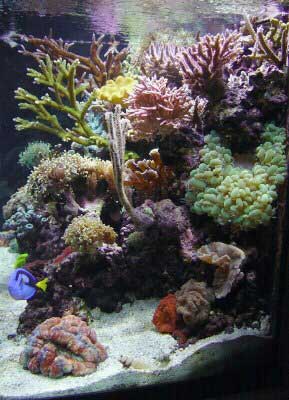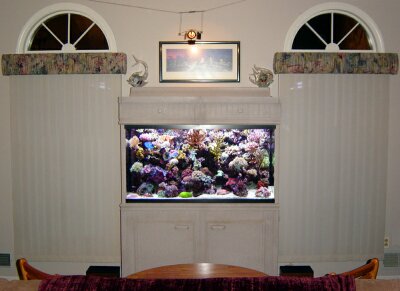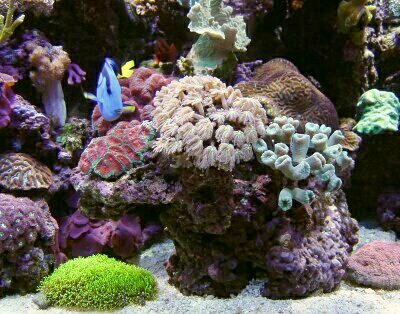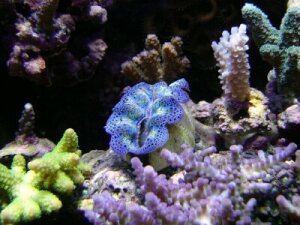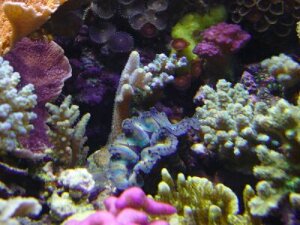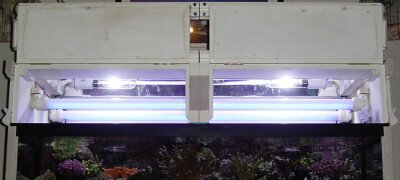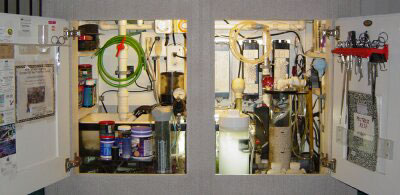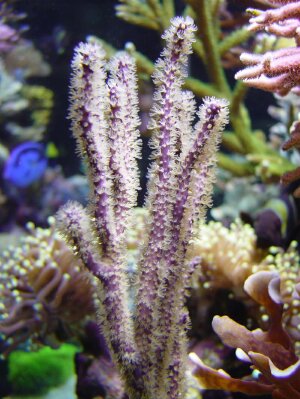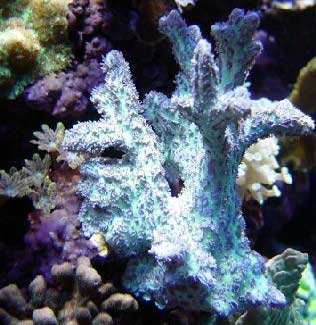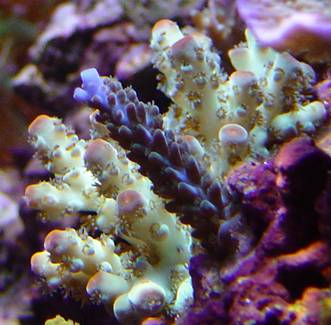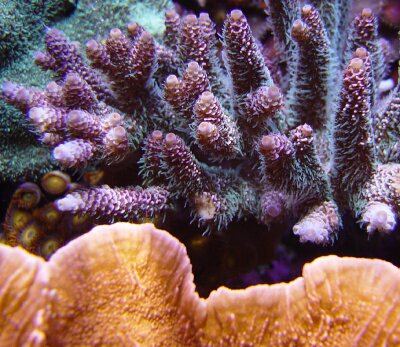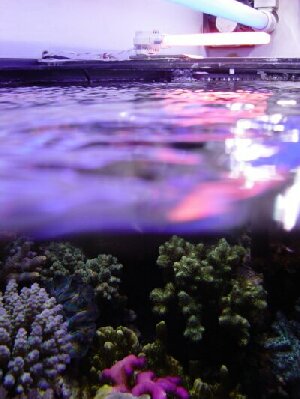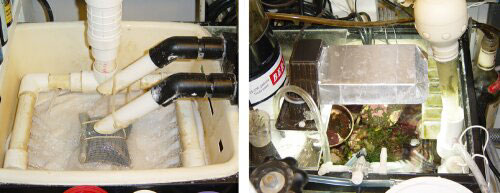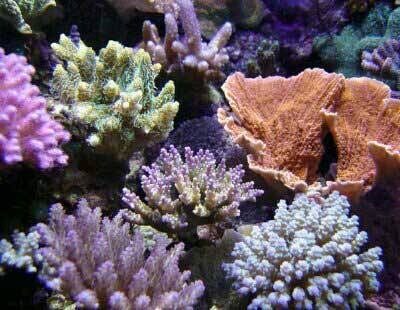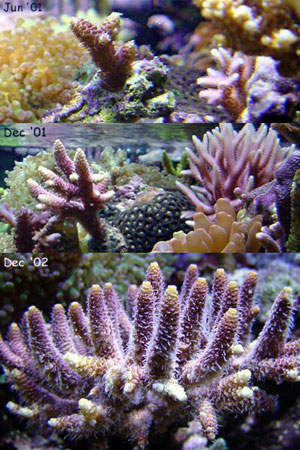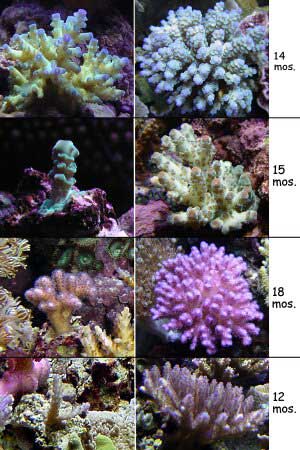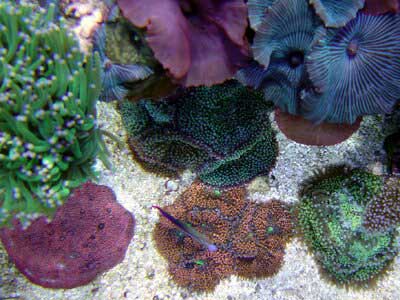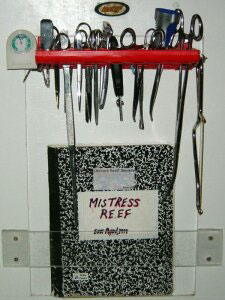Dave Playfair's Reef Aquarium
Background:
Since her christening in April 1999,
and previous Tank of the Month feature in November
2000, Mistress Reef has undergone surprisingly
few modifications. Aside from larger pumps and adding reactors
to compensate for increased bioload, most of my early setup
decisions panned out successfully. I've tried to maintain
a consistent reef philosophy involving simplicity, efficiency,
and cost effectiveness, yet still providing an environment
which promotes the health of my inhabitants. Throughout
the past four years, the focus of my reefkeeping has remained
the same: to create a work of living sculpture. Along the
way I am perpetually learning about these delicate ecosystems.
Though I began this endeavor partly for its attractiveness
as an individual activity (not dependent on others or the
weather), I've ironically formed many lasting friendships
both locally and virtually, which otherwise would have been
missed.
|
|
 |
|
Aquarium Profile:
|
•
|
120-gallon
AGA "reef ready" aquarium 48" x
24" x 24" |
|
•
|
20L
gallon sump/refuge |
|
•
|
DIY custom cabinet
and canopy |
|
•
|
200 lbs. of liverock
and 80 lbs. (~1") of mixed-grain substrate
|
|
|
Water
Parameters:
|
•
|
Salinity: 35ppt (refractometer)
|
|
•
|
Temp: 79°F winter, 82°F
summer (Omega) |
|
•
|
pH: 7.8-8.0 (Hanna pHep) |
|
•
|
Calcium: 400 (Salifert) |
|
•
|
Alkalinity: 9dKH (Salifert) |
|
•
|
NO3:
0 (Salifert) |
|
Plumbing and Circulation:
Return from the sump is via an externally
plumbed Mag18, pushing nearly 800 gph through two rear corner
flairs in the display tank. A Maxijet 1200 is located in
each of the two built-in overflows, and is plumbed with
Locline to opposite top front corners of the tank. Limited
overflow capacity required that only one power head be on
at a time, so a DIY wavemaker alternates at 30 second intervals.
The AGA stock standpipes have been modified to raise the
chamber water level several inches so bubbles sucked into
the powerheads are reduced. Most other plumbing is rigid
PVC. To provide circulation behind the "reef slope",
there is an internal Rio 2500 on a spray bar against the
back glass, completely hidden behind the rockwork.
Lighting:
The inside of the canopy still has it's
original white two-part epoxy paint, which has held up quite
well considering the abuse it gets. Two specular aluminum
reflectors were modified to fit into the raised vault of
the hood, and these are due to be replaced in the spring
during a canopy "overhaul" with DIY pieces. Daylight
is provided from two 175-watt Ushio metal halide lamps,
powered by Advance F-can ballasts. Fluorescent illumination
comes from two 110-watt VHO actinic URI lamps run from an
IceCap 430 ballast. Evening and "on demand" late
night illumination is via a "red" 9-watt PC lamp
(located on the center brace), running from an ordinary
"exit sign" ballast. The sump is lit by a 27-watt
PC quad lamp, whose ballast was part of an old outdoor yard
light. Its photoperiod is on the reverse schedule of the
tank. All of the lighting is controlled through four individual
timers.
-
-
- 20:00 PC On
- 20:30 MH's Off
- 21:30 VHO's Off
- 22:00 PC Off
|
Temperature Control:
A dual range temperature controller
runs both the 250 watt EboJager heater and the twin 4.5"
DC canopy fans, based on the water temperature of the tank.
This method provides exceptionally tight temperature control
(typically less than 0.5°F variation) and is quite efficient
as the fans only come on when needed (regardless of the
light mode), and the heater will never be on simultaneously
with the fans. Evaporation is reasonable (typically less
than 1.5 gals/day) because of the control and enclosed hood.
The drawbacks to this setup include high internal canopy
temperatures (before the water heats up to turn the fans
on), and condensation inside the canopy overnight. Convection
vents at the top allow natural air circulation to reduce
both of these conditions. During the summer months the tank
is set at 82°F (house set to 76-78°F), and during
the winter it is slowly lowered to 79°F (house set to
69°F). I may take several months to transition between
these temperatures, based on the local temperatures.
Additive Supplementation:
Although I admit to owning a few snake
oils, they are rarely used. Besides water changes, a calcium
reactor (a Geo with gas recirculation modification) provides
the bulk of mineral replacement. The effluent is set at
80ml/min (pH 6.9) and CO2 at 40 bubbles/minute
(media consumption ~1.25 lb. of CaribSea A.R.M. per month).
Quite recently a DIY kalkwasser reactor was added for all
top off water to help prevent pH depression from what I
believe is due to the heavy invertebrate bioload.
Top-off System:
A 50 gpd RO with a three gallon pressurized
storage tank and auto shut-off is located remotely and plumbed
to the tank (and fridge :c). A DI cartridge polishes the
water prior to entering the kalk reactor. A sump float switch
is directly wired to a solenoid valve, allowing make up
water into the sump at a rate controlled by a needle valve.
A timer restricts top off to an hour every 8-12 hours at
a rate of 100ml/hour or less. An additional high limit float
switch provides further redundancy. Thus, even if the solenoid
valve fails 'open', it would take close to 8 hours to fill
the sump with 10 gallons of water.
Filtration:
The overflows empty into a modified dish
pan suspended on one end of the 20L sump. I used to periodically
run floss (especially when "storming" the rock)
under the outlet, and have always used about 1/2 cup of
SeaChem Matrix carbon changed every week. About a year ago
I noticed a general degradation in the health of the tank,
so I started filtering the water more routinely. A 12"
x 12" pad is now replaced every three days. A stock
RedSea Berlin Classic powered from a Mag 7 (with inlet sponge
to prevent impeller lock up via particulate) sits in the
sump and does a minimal job of removing organics from the
water column. About 1-1.5 cups of skimmate is removed per
month.
Maintenance:
I usually spend a solid 10 hours per
week taking care of this tank and it's inhabitants (my spouse
says it's much longer). I really don't know where the time
goes, but a great deal of it is spent "gardening".
Without constant intervention, "everyone would end
up killing themselves", since each coral's goal in
life is to take over their world! The rocks are basted off
at least once per week along with a skimmer top end clean
out. I periodically run fresh water through its venturi
air intake such that total teardown is seldom required.
I can always find something to do!
Feeding:
Nori is provided most days during the
morning, and frozen food (Prime Reef or Mysis shrimp
@ 2 cubes per feeding) or flake is fed on alternate evenings.
Some LPS corals are periodically target fed with small pieces
of frozen shrimp. The rest get a moderate pinch of Vibra
Gro, rolled between the thumb and forefinger underwater
so it dissolves into a cloud (many thanks to Gary for this
tip).
Inhabitants:
Eleven fish, several shrimp, two crabs
and about 140 different corals call this aquarium home...
|
Centropyge
bispinosus
(Coral beauty)
|
Nemateleotris
decora
(Firefish goby)
|
Pterapogon kauderni
(Bangaii cardinal)
|
|
Premnas
biaculeatus
(Gold stripe maroon clownfish)
|
Sphaeramia
nematopterus
(Pajama cardinal)
|
Paracanthurus
hepatus
(Hippo tang)
|
|
Neocirrhitus
armatus
(Flame hawkfish)
|
Sphaeramia
nematopterus
(Purple firefish)
|
Amblyeleotris
guttata
(Orange spotted prawn goby)
|
|
Synchiropus
splendidus
(Mandarin dragonet)
|
|
Acanthurus
leucosternon
(Powder blue tang)
|
|
Acropora
spp.
(Acros!)
|
Montipora
spp.
(Plate/Branching)
|
Pachyseris sp.
(Wrinkle)
|
|
Seriotopora
sp.
(Birdsnest)
|
Pocillopora
spp.
|
Stylophora
pistillata
(Cat's Paw)
|
|
Pavona
spp.
(Cactus)
|
Leptoseris
sp.
|
Hydnophora
sp.
(Horn)
|
|
|
Porites spp.
|
|
|
Euphyllia
spp.
(Torch, Frogspawn)
|
Trachyphyllia
spp.
(Open Brain)
|
Plerogyra sinuosa
(Green Bubble)
|
|
Blastmussa
spp.
(Flower)
|
Leptoria
phyrgia
(Maze)
|
Pectinia
paeonia
(Lettuce)
|
|
Merulina
spp.
(Brain)
|
Faviid
sp.
(Moon Crator)
|
Caulastria
spp.
(Trumpet)
|
|
Echinophyllia
spp.
(Plating)
|
Turbinaria sp.
(Yellow Scroll)
|
Glaxea
fascicularis
(Galaxy)
|
|
Capnella
sp.
(Flowering Leather)
|
Gorgonia
sp.
(Purple Sea Rod)
|
Sinularia spp.
(Finger Leather, Cabbage)
|
|
Lobophytum
sp.
(Crown Leather)
|
Sarcophyton
elegans
(Yellow Leather)
|
Nepthea
sp.
(Neon Green Finger Leather)
|
|
Xenia
spp.
(Waving Hand)
|
Tubipora
musica
(Pipe Organ)
|
Discosoma
spp.
(Smooth Mushrooms)
|
|
Rhodactis
spp.
(Fancy Mushrooms)
|
Ricordea floridea
(Coolest Mushrooms)
|
Pachyclavularia
sp.
(Green Stars)
|
|
Clavularia
spp.
(Glove Polyps)
|
|
Zooanthus
spp.
(Button Polyps)
|
|
3"
Tridacna maxima
|
|
2" Tridacna crocea
|
|
Miscellaneous
Invertebrates
|
|
Alpheus
bellulus
(Tiger Pistol shrimp)
|
Ophiomyxa
spp.
(Red Serpent Star/Brittle Star)
|
Lysmata amboinensis
(Cleaner shrimp)
|
|
Lysmata
wurdemanni
(Peppermint shrimp)
|
Mithraculus
sculptus
(Emerald crab)
|
Percnon
planissimum
(Sally Lightfoot crab )
|
Conclusion:
For me, reef keeping is the final frontier
after decades of maintaining various aquaria. I believe
the challenge of such a dynamic ecosystem is what keeps
it exciting. Initially, our goal might be centered around
survival... As we progress, the objective matures toward
longevity, then growth, color, and ultimately propagation
and breeding. With so many disciplines to draw from (biology,
chemistry, gardening, electricity, plumbing, and especially
the art of patience), there is always something to hold
our interest, not to mention build character!
My personal preference towards a relatively
high number of smaller colonies is in part due to trading
amongst fellow hobbyists. The initial "plan" was
to continually search for the "ultimate" coral
(the quest is half the fun!), knowing that eventually each
new addition would push a less interesting piece back to
the LFS. However, since each animal has a unique story behind
it, I have a difficult time choosing and have kept most.
Over the past year, pruning has increased to the point that
I can routinely offer fragments to fellow hobbyists. It's
very rewarding, albeit a lot of work, to share corals that
I once obtained similarly! With no plans to setup additional
growout tanks (the mistress and my family wouldn't appreciate
their lost time), the trick has been to maintain a manageable
scale of selective propagation which allows the hobby to
financially maintain itself.
Thank you Reef Central, for allowing
me to share this honor once more. We are quite fortunate
to have each other through this medium to facilitate the
learning process that propels captive reef keeping. I truly
hope both the hobbyists and the industry behind them will
share the responsibility in securing our future, not only
through captive-raised animals, but also from sustainable
wild harvesting. That is the only way to insure that reef
aquariums won't become something we can only read about.
To visit Dave's website
click on the image below:
Feel free to comment
or ask questions about my tank in the forum
for the online magazine.
|




